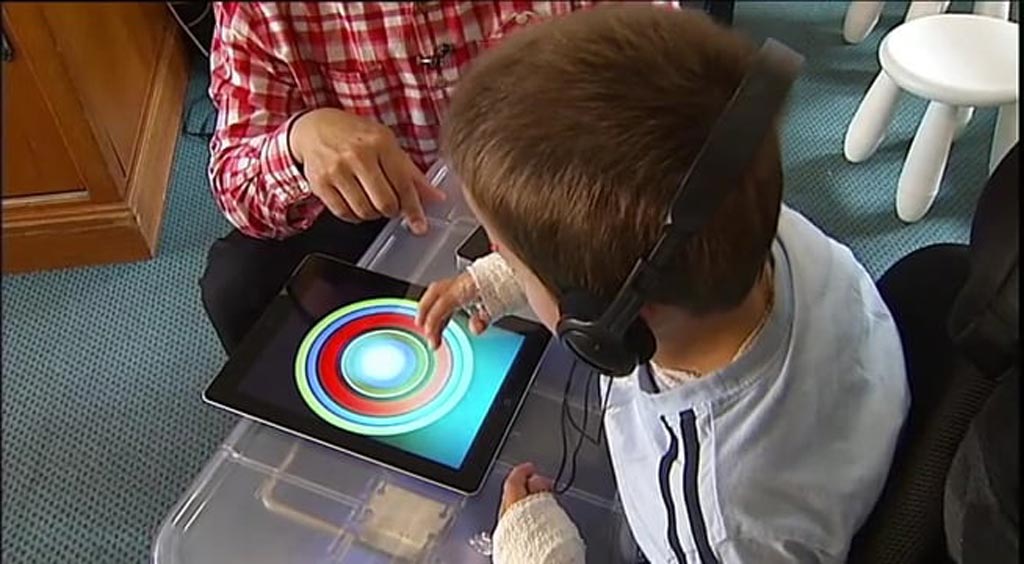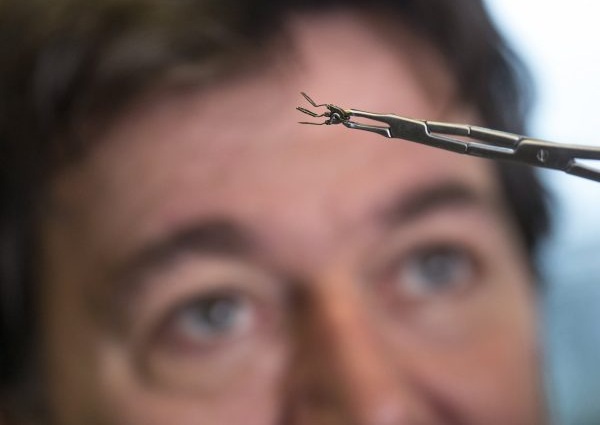Relaxation App Helps Children Cope with Procedural Pain
|
By HospiMedica International staff writers Posted on 03 May 2018 |

Image: A child practicing biofeedback with the Brighthearts app (Photo courtesy of George Khut).
A new study describes how a biofeedback‐assisted relaxation application helps children control procedural pain, such as during peripheral blood collection and cannulation.
Researchers at Children's Hospital at Westmead (Australia), the University of Sydney (Australia), and other institutions conducted a study involving 30 children (7 to 18 years of age) who underwent peripheral blood collection, botulinum toxin injection, or intravenous cannula insertion. The study was designed to evaluate BrightHearts, a biofeedback mediation relaxation app designed for mobile phones and tablet computers that responds to changes in heart rate, and which can be used to teach children biofeedback-assisted relaxation.
For the study, BrightHearts was delivered via an iPad, with heart rate measured via a pulse oximeter worn on the ear or thumb. Feasibility was assessed through observations and patient, parent/carer, and healthcare professional feedback surveys developed by the researchers. The results revealed that 83% of the children reported that they found the relaxation helpful during the procedure, and that they would use it again, as did 64% of healthcare providers. All parents and 96% of healthcare professionals indicated they would use BrightHearts again. The study was published on April 17, 2018, in Pain Practice.
“This is an innovative collaboration between art and medicine that we hope will improve the lives of children living with chronic illness. Children at the hospital contributed to the design of BrightHearts, so it’s very much about creating something that will make their experience in hospital less frightening,” said corresponding author Angela Morrow, MD, of Children's Hospital at Westmead and the University of Sydney. “Future studies are required to evaluate BrightHearts’ efficacy in reducing pain and anxiety during painful procedures and distinguish the effects of a biofeedback mediated app from distraction.”
BrightHearts, developed by artist George Khut, PhD, of the University of Sydney, combines standard distraction methods with the principals of biofeedback relaxation training in order to focus children’s attention away from their object of their anxiety and fear, and help them develop skills for observing and regulating their response during painful procedures. Both before and during such anxiety provoking procedures, children are rewarded with sounds and visuals that respond to decreases in heart rate over different periods of time, which they learn to influence with their breathing and relaxation techniques.
Related Links:
Children's Hospital at Westmead
University of Sydney
Researchers at Children's Hospital at Westmead (Australia), the University of Sydney (Australia), and other institutions conducted a study involving 30 children (7 to 18 years of age) who underwent peripheral blood collection, botulinum toxin injection, or intravenous cannula insertion. The study was designed to evaluate BrightHearts, a biofeedback mediation relaxation app designed for mobile phones and tablet computers that responds to changes in heart rate, and which can be used to teach children biofeedback-assisted relaxation.
For the study, BrightHearts was delivered via an iPad, with heart rate measured via a pulse oximeter worn on the ear or thumb. Feasibility was assessed through observations and patient, parent/carer, and healthcare professional feedback surveys developed by the researchers. The results revealed that 83% of the children reported that they found the relaxation helpful during the procedure, and that they would use it again, as did 64% of healthcare providers. All parents and 96% of healthcare professionals indicated they would use BrightHearts again. The study was published on April 17, 2018, in Pain Practice.
“This is an innovative collaboration between art and medicine that we hope will improve the lives of children living with chronic illness. Children at the hospital contributed to the design of BrightHearts, so it’s very much about creating something that will make their experience in hospital less frightening,” said corresponding author Angela Morrow, MD, of Children's Hospital at Westmead and the University of Sydney. “Future studies are required to evaluate BrightHearts’ efficacy in reducing pain and anxiety during painful procedures and distinguish the effects of a biofeedback mediated app from distraction.”
BrightHearts, developed by artist George Khut, PhD, of the University of Sydney, combines standard distraction methods with the principals of biofeedback relaxation training in order to focus children’s attention away from their object of their anxiety and fear, and help them develop skills for observing and regulating their response during painful procedures. Both before and during such anxiety provoking procedures, children are rewarded with sounds and visuals that respond to decreases in heart rate over different periods of time, which they learn to influence with their breathing and relaxation techniques.
Related Links:
Children's Hospital at Westmead
University of Sydney
Latest Critical Care News
- AI Model Analyzes Patient Data to Diagnose Multiple Sclerosis With 90% Accuracy
- Magnetically Navigable Microparticles Enable Targeted Drug Delivery
- AI-Powered Algorithm Automates Analysis of Coronary Stents After Implantation
- New Stroke Risk Scoring System to Help Avoid Unnecessary Surgeries
- Wearable Device Tracks Individual Cells in Bloodstream in Real Time
- Drug Delivery System Uses Ultrasound-Activated Nanoparticles to Destroy Bacterial Biofilms
- New Potent Injectable Therapy Could Prevent Heart Failure After Heart Attack
- Hospital-Based System Combines AI and Genomic Surveillance to Quickly Detect Infectious Disease Outbreaks
- New Approach to Visualizing Blood Pressure Data Can Help Better Manage Hypertension Patients
- Breakthrough AI Technology Accurately Assesses Heart Failure Severity
- Smart Bandage Monitors Chronic Wounds in Human Patients
- AI Identifies Patients with Increased Lung Cancer Risk Up To 4 Months Earlier
- Next Gen Hemodynamic Monitoring Solution Provides AI-Driven Clinical Decision Support
- AI Algorithm Identifies High-Risk Heart Patients
- Wearable Glucose Monitor Offers Less Invasive Approach to Assessing Diabetes Risk
- Wireless, Self-Powered Smart Insole to Improve Personal Health Monitoring
Channels
Surgical Techniques
view channel
DNA Origami Improves Imaging of Dense Pancreatic Tissue for Cancer Detection and Treatment
One of the challenges of fighting pancreatic cancer is finding ways to penetrate the organ’s dense tissue to define the margins between malignant and normal tissue. Now, a new study uses DNA origami structures... Read more
Pioneering Sutureless Coronary Bypass Technology to Eliminate Open-Chest Procedures
In patients with coronary artery disease, certain blood vessels may be narrowed or blocked, requiring a stent or a bypass (also known as diversion) to restore blood flow to the heart. Bypass surgeries... Read more
Intravascular Imaging for Guiding Stent Implantation Ensures Safer Stenting Procedures
Patients diagnosed with coronary artery disease, which is caused by plaque accumulation within the arteries leading to chest pain, shortness of breath, and potential heart attacks, frequently undergo percutaneous... Read more
World's First AI Surgical Guidance Platform Allows Surgeons to Measure Success in Real-Time
Surgeons have always faced challenges in measuring their progress toward surgical goals during procedures. Traditionally, obtaining measurements required stepping out of the sterile environment to perform... Read morePatient Care
view channel
Portable Biosensor Platform to Reduce Hospital-Acquired Infections
Approximately 4 million patients in the European Union acquire healthcare-associated infections (HAIs) or nosocomial infections each year, with around 37,000 deaths directly resulting from these infections,... Read moreFirst-Of-Its-Kind Portable Germicidal Light Technology Disinfects High-Touch Clinical Surfaces in Seconds
Reducing healthcare-acquired infections (HAIs) remains a pressing issue within global healthcare systems. In the United States alone, 1.7 million patients contract HAIs annually, leading to approximately... Read more
Surgical Capacity Optimization Solution Helps Hospitals Boost OR Utilization
An innovative solution has the capability to transform surgical capacity utilization by targeting the root cause of surgical block time inefficiencies. Fujitsu Limited’s (Tokyo, Japan) Surgical Capacity... Read more
Game-Changing Innovation in Surgical Instrument Sterilization Significantly Improves OR Throughput
A groundbreaking innovation enables hospitals to significantly improve instrument processing time and throughput in operating rooms (ORs) and sterile processing departments. Turbett Surgical, Inc.... Read moreHealth IT
view channel
Printable Molecule-Selective Nanoparticles Enable Mass Production of Wearable Biosensors
The future of medicine is likely to focus on the personalization of healthcare—understanding exactly what an individual requires and delivering the appropriate combination of nutrients, metabolites, and... Read more
Smartwatches Could Detect Congestive Heart Failure
Diagnosing congestive heart failure (CHF) typically requires expensive and time-consuming imaging techniques like echocardiography, also known as cardiac ultrasound. Previously, detecting CHF by analyzing... Read moreBusiness
view channel
Expanded Collaboration to Transform OR Technology Through AI and Automation
The expansion of an existing collaboration between three leading companies aims to develop artificial intelligence (AI)-driven solutions for smart operating rooms with sophisticated monitoring and automation.... Read more















